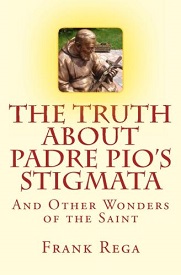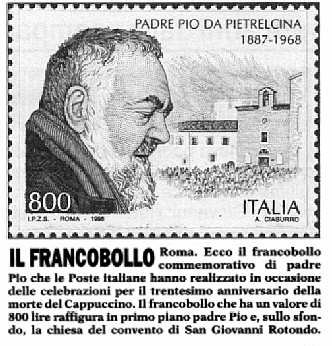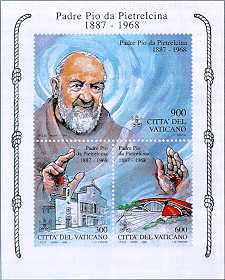
Source Material on the Flying Monk
Note: There is a similarity among all three selections below, which suggests that they come from a common source document. Whether the source document is one of these three, or a fourth document, is unknown at this time.
Below passage was translated by Frank
Rega from the Italian from the book:
I Miracoli di Padre Pio, by Renzo Allegri,1993 Arnoldo Mondadori Editore S.p.A.,
Milano (Italy), 1993, Pages 110-111. ISBN 88-04-41322-0
Many Allied aviation pilots of various nationalities
(English, American, Polish, Palestinian) and of varied religions (Catholic, Orthodox,
Moslem, Protestant, Jewish) who during the Second World War, after September 8, 1943, were
based in Bari to undertake missions on Italian territory, testified to an amazing
occurrence.
Each time, while fulfilling their Italian military mission, they approached the zone of
the Gargano, in the environs of San Giovanni Rotondo, they saw in the sky a Friar, who in
stretching out his wounded hands, prevented them from dropping their bombs. Foggia and
almost all of the centers of Puglia were subjected to repeated bombardment; on San
Giovanni Rotondo not one bomb fell.
This event, which is to say the least unheard of, was
directly witnessed by the general of Aeronautica Italiana Bernardo Rosini, who at that
time was part of the "United Air Command" operating out of Bari with the Allied
air forces. "Each time that the pilots returned from their missions," General
Rosini told me, "they spoke of this Friar that appeared in the sky and diverted their
airplanes, making them turn back.
"Everyone laughed at these incredulous stories. But
since the episodes kept recurring, the Commanding General decided to intervene
personally. He took command of a squadron of bombers to destroy a cache of German
war materials that was said to be right in San Giovanni Rotondo. Up until that time, no
one had ever succeeded in going in that direction because of the presence in the air of
that mysterious phantasm which forced the airplanes back.
"Since this had been happening for some time, at the base there was much
apprehension. We were all curious to see the results of this operation. When the squadron
returned, we went over to ask what had occurred. The American general was quite
upset. He recounted that as soon as they arrived near the target, he and his pilots had
seen rising up into the sky the figure of a monk with his hands held high. The bombs
dropped all by themselves, falling in the woods, and the planes turned in retreat, without
any intervention on the part of the pilots.
"That evening, the episode was the main topic of
conversation. Everyone was wondering who was this specter which the airplanes mysteriously
obeyed. Someone said to the Commanding general that at San Giovanni there lived a
Priest with the stigmata whom everyone considered a saint, and that perhaps he was the
very one responsible for diverting the planes. The general found this hard to believe, but
as soon as it was possible, he wished to go there to find out.
"After the war, the general, accompanied by a few
pilots, arrived at the Capuchin Convent. As soon as he crossed the threshold of the
sacristy, he found himself facing a number of Friars, among whom he recognized immediately
the one who had stopped his airplanes. Padre Pio went up to meet him, and putting a hand
on his shoulders, said to him: "So it is you, the one who wished to do away with all
of us".
"Astonished at seeing and hearing the Friar, the
general kneeled before him. Padre Pio had spoken in his usual Benevento dialect, but the
general was convinced that the Priest has spoken in English. The two became friends. The
general, who was a Protestant, converted to Catholicism.
Below passage was translated by Frank
Rega from the Italian from the book:
Storia Di Padre Pio, by Rino Cammilleri, Edizioni Piemme Spa. (Italy) 1993 Pages
81-82.
Didn't they know well these stigmata, those pilots from
the Second World War who were unsuccessful in bombing San Giovanni Rotondo, because they
were "stopped in the heavens" by a Friar with wounded hands? They were English,
American, Palestinian, and Polish. And they were not all Catholics: among them were Jews,
Orthodox, Protestants, Moslems, and hard-core atheists. Naturally, when they returned to
base they kept their mouths shut. And who would have believed them anyway? It would have
been explained away as stress, bombing syndrome, or even drunkenness on duty. But at war's
end, they read about Padre Pio in the newspapers, and began visiting the monastery at San
Giovanni Rotondo. Yes, it was in fact him, the same bearded Friar with the bleeding wounds
that they had seen in the clouds of the sky with his arms spread apart.
One American pilot found out that his mother had been
praying for him before a picture of Padre Pio. This pilot and his co-pilot had crashed
their plane after seeing the Friar in the sky. They both came out of the wreck unhurt.
Below passage translated from the Italian by Jeanette and Joan Salerno, and Michael Simone, from: Gente Magazine, Vol. 38, July 18, 1994, pages 44-45, article on Padre Pio, Sixth Installment, by Dino Cimagalli.
The American fighter dived down to attack the anti-aircraft. This was the Gargano mountain, the area that on the map was marked with a little circle and a red "X". The town was called San Giovanni Rotondo, but to the pilot and his bombardier, that name meant nothing. They knew only that somewhere there was a guarded arsenal of German arms and that they had to destroy it.
"Pilot to bombardier. It's impossible to identify the principal object. You have to drop in a wide range." They knew the arsenal existed, but they didn't know the precise location. Therefore, not to make any mistake, they would have to bomb the entire town.
"Attention," said the pilot. And after a few seconds, "Now! Go!" The bombardier activated the bomb doors. Nothing. The mechanism that would have put into motion the deadly load remained hermetically and obstinately closed. He pushed the button once, twice, three times. The result zero. "Go ahead, release!" cried the pilot. "I can't circle forever up here. The Germans will do us in."
"I don't understand. The door must be jammed," the bombardier frenetically replied. "Circle around again, I"ll try again." But to no avail. The bombs refused to leave their lodging. Then suddenly the pilot, quickly aiming the nose of the plane high, cried on the intercom, "My God, my God, let's return to base immediately."
At the base the mechanics checked the bomb mechanism; everything was in order, nothing unusual. The malfunctioning of the doors was mechanically unexplainable.
The bombardier then had another query. He wanted to know from his flight companion why he had cried , "My God!" and then darted away, as though he had all the German fighters at his heels. "I'll tell you ," replied the pilot. "But swear to me you won't say a word to anyone. Otherwise they'll think we're both nuts." The bombardier, still more curious, promised.
"Something impossible happened," the pilot continued. "While I was circling low, high on the mountain I saw something, in fact someone... I know, it's difficult to believe, but it was a Friar, a gigantic friar suspended in the sky, with his arms thrown open, as if to stop the plane."
"Too many hours of flying," commented the bombardier. "It must have been an hallucination. You need to see a doctor".
If only they knew that that impossible vision was also being seen by others. The fact is that no one talked about it, for fear of being taken for a nut. It was only after the war was over, when the Gargano area was liberated, that pilots confided in each other their secret: the legend of the "line of the flier," the forbidden horizon beyond which one could not go, because the motors reversed and the planes ran the risk of stalling.
We do not need much to imagine who the ethereal friar was who blocked the allied planes, and saved San Giovanni Rotondo from the destruction that was visited on towns and cities not too far from there. It was the same in July, 1942, when the axis forces (Berlin-Rome-Tokyo) appeared projected toward an irresistible victory, when he had asked a question of Dr. Allesandri (one of his spiritual children, later high magistrate in Florence): "When will the allies invade?" The doctor replied, thinking that Friar joked, "Allied invasion? But we're winning on all fronts. Tell me Padre, you're not being influenced by the propaganda of radio London, are you?" And the friar, with a far-away look and a furrowed brow said "You will will see, to come here to see me in a little while, it will require a passport. When we seen each other again, we won't recognize each other".
Yes, naturally it was Padre Pio who prophesized the outcome of the conflict, spelling out the scope of the victors and the conquered, going against any forecast dictated by logic and the most recent war bulletins. His vision was exactly right. On his personal battle against the allied forces that tried to bomb San Giovanni Rotondo he never said a thing, not even afterward. He only let slip a revealing allusion after the war.
Bernardo Rosini, a general of the Italian Air Force, told a story (and he was not the only one). "At Bari was located the general command of the U.S. Air Force. I know several officers who told me of having been saved by Padre Pio during air missions. Even the commanding general was a protagonist in one of the most sensational epsodes.
It was an episode that seemed a carbon copy of a hundred others, as if by by some design, for the protection of San Giovanni Rotondo. "One day," General Rosini continued, this American commander wanted to lead a squadron of bombers himself to destroy the German arms depository of war materiel that was located at San Giovanni Rotondo. The commander related that as he approached the target, he and his pilots waw rising in the sky the figure of a friar with his hands held outward. The bombs released of their own accord, falling in the woods, and the planes completely reversed course without any intervention by the pilots."
Someone told the commanding general that in a convent at this little town of San Giovanni Rotondo, there lived a saintly man, a friar in the odor of sanctity. At war's end, the general wanted to go meet this person. "He was accompanied by several pilots," Rosini continued. "He went to the convent of the Capuchins. As soon as he crossed the threshold of the sacrisity he found himself in front of several friars, among whom he immediately recognized the one who had 'stopped' his planes. Padre Pio went forward to meet him, and putting his hand on his shoulder, he said, "So, you're the one who wanted to get rid of us all!" If there had been any doubt before....
See Disclaimer regarding Italian translations on my main page.
Packed with other interesting Padre Pio articles and stories, the above book is available in print or Kindle format.
Frank Rega is the author of: Padre
Pio and America,
St.
Francis of Assisi and the Conversion of the Muslims,
The
Greatest Catholic President: Garcia Moreno of Ecuador
Life of the Mystic Luisa Piccarreta
- Journeys in the Divine Will vols. 1 and 2
Life of the Mystic Luisa
Piccarreta - volume 3 in preparation
The
Truth about Padre Pio's Stigmata and Other Wonders of the Saint
Vatican II, Evolution, and Medjugorje: Hubris, Heresy, and Mystery
www.frankrega.com www.sanpadrepio.com www.thepoverello.com www.lifeofluisa.com



Stamps issued by Italy and the Vatican to commemorate the life of Padre Pio.
This page
was last updated on 11/01/2008.
Copyright 1998 Frank M. Rega